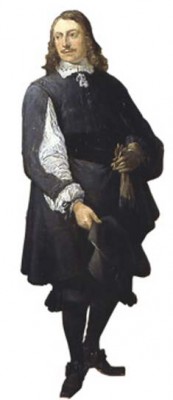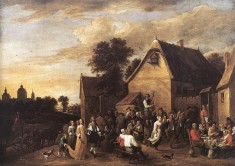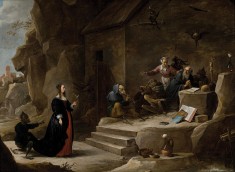| David Teniers the Younger | |
|---|---|
 |
|
| Born | David Teniers Dec. 16, 1610 Antwerp, Belgium |
| Died | Apr. 25, 1690 (at age 79) Brussels, Belgium |
| Nationality | Flemish |
| Movement | Baroque |
| Field | Painting |
| Works | |
David Teniers the Younger was a very famous Flemish artist that was born in Antwerpen (Antwerp), Belgium, in 1610. Although he painted a number of different subjects, he is most famous for his lively paintings of humble peasant life. He created these pieces with numerous details as well as a sense of humor.
Teniers also created many works of art that were typically busy with various activities that covered the entire canvas. These were frequently of outdoor scenes that depicted the customary Flemish kermesse, or feast. His paintings are displayed in many museums across Europe and the United States.
Teniers’ Family Life
There is not much known about the early life of David Teniers the Younger. His father was David Teniers who most likely trained his son in his artistic ways. Both his son and grandson were painters. In 1637, Teniers the Younger married Anna Brueghel, the daughter of painter Jan Brueghel, and also the granddaughter of painter Pieter Bruegel.
The artist, Adriaen Brouwer, was also a very important influence in his life. Two other strong artistic influences in Teniers the Younger’s life were Rubens and Elsheimer, both of whom influenced his father as well.
Teniers the Younger’s Early Work
From the very beginning of his career, Teniers the younger was an incredibly productive painter. He had good relationships with many of Antwerp’s art dealers. In the 1630s, he created many small religious scenes on commission for Chrysostoom van Immerseel, an art dealer than supplied paintings for the Spanish art market. In 1632, Teniers the Younger was admitted into the Guild of St. Luke as a “master.”
As a young master, he painted portraits of historical figures, religious scenes, everyday life scenes, landscapes, pastorals, portraits for the Infantry Guilds’ members, and mythological and allegorical compositions. He created many paintings that were quiet and peaceful in character. He chose to paint many works that showed outdoor action such as peasants harvesting and looking after their livestock. Teniers produced many chronicles of everyday Flemish life during his earlier artistic years.
Many of his peasant life pieces were greatly valued by several art dealers in his birthplace. As a result, these works made him very famous. He swiftly became one of the city’s most successful artists, which is one of the reasons he became the Office Master at St. Jacobskerk from 1637 to 1639. He was also the Dean for the Guild of St. Luke in 1644.
Mature Stage of His Work
 Teniers the Younger was becoming a well-known painter and he was getting the attention of royal families. Spain’s King Philip IV commissioned several paintings by David Teniers the Younger. Christina of Sweden and Prince William II of Orange also collected his paintings. Don Juan of Austria even became one of his art students.
Teniers the Younger was becoming a well-known painter and he was getting the attention of royal families. Spain’s King Philip IV commissioned several paintings by David Teniers the Younger. Christina of Sweden and Prince William II of Orange also collected his paintings. Don Juan of Austria even became one of his art students.
In 1647, Teniers the Younger was employed by Archduke Leopold William, who was a lover of great art. Teniers became the court painter in Brussels in 1651. The archduke had a prominent collection of works of art which later became part of Vienna’s Kunsthistorisches Museum. Teniers created several paintings that are a part of this famous collection.
Later Years and Death
In 1656, Teniers the Younger’s wife died. Before long, he married his second wife, Isabella de Fren. In 1663, he was named the first director of the Art Academy of Antwerp. His second wife, Isabella, died in 1683. He struggled with illness and family legal conflicts in his later years. David, his oldest son, passed away in 1685. He was an  artist of reputation and talent as well. Teniers the Younger died in Brussels at the age of 80 in April of 1690.
artist of reputation and talent as well. Teniers the Younger died in Brussels at the age of 80 in April of 1690.
The Legacy of David Teniers the Younger
Teniers the Younger was a very prolific painter throughout his lifetime and he created over 1,000 works of art. He was especially popular in France. His work was copied by many of his followers, which included his son, David Teniers III. His later works were mostly pastoral and very idyllic in nature.
Smith’s Catalogue Raisonné has over 900 descriptions of his paintings that have been approved as his original work. Very few artists produced so many paintings with such ease. Many of his smaller paintings, landscapes with figures, are called afternoons because he created them in very little time.
Museums in Brussels, Dresden, London, Madrid, Munich, Paris, St. Petersburg and Vienna have more than 200 of his works of art by Teniers the Younger. Over 100 paintings are held in private collections in the United Kingdom. Several of the other of Teniers’ paintings are owned by private art collectors throughout the world. Two of his more famous paintings are The Five Senses and The Prodigal Son.